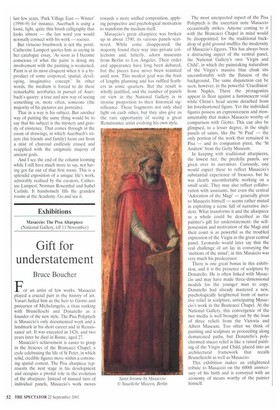Exhibitions
Masaccio: The Pisa Altarpiece (National Gallery, till 11 November)
Gift for understatement
Bruce Boucher
For an artist of few works, Masaccio played a crucial part in the history of art. Vasari hailed him as the heir to Giotto and precursor of Michelangelo, a titan ranking with Brunelleschi and Donatello as a founder of the new style. The Pisa Polyptych is Masaccio's only documented work and a landmark in his short career and in Renaissance art. It was executed in 1426, and two years later he died in Rome, aged 27.
Masaccio's achievement is easier to grasp in the frescoes of the Brancacci Chapel, a cycle celebrating the life of St Peter, in which solid, credible figures move within a convincing spatial context. The Pisa altarpiece represents the next stage in his development and occupies a pivotal role in the evolution of the altarpiece. Instead of massed tiers of individual panels, Masaccio's work moves towards a more unified composition, applying perspective and psychological motivation to transform the medium itself.
Masaccio's great altarpiece was broken up in about 1590, its various panels scattered. While some disappeared, the majority found their way into private collections and, latterly, adorn museums from Berlin to Los Angeles. Their order and appearance have long been debated, but the pieces have never been reunited until now. This modest goal was the fruit of lengthy planning and has ruffled feathers in some quarters. But the result is wholly justified, and the number of panels on view in the National Gallery is in inverse proportion to their historical significance. These fragments not only shed light on each other, but they also give us the rare opportunity of seeing a great Renaissance artist evolving his own style.
The most unexpected aspect of the Pisa Polyptych is the uncertain note Masaccio occasionally strikes. Anyone coming to it with the Brancacci Chapel in mind would be disappointed, for the traditional backdrop of gold ground muffles the modernity of Masaccio's figures. This has always been a distracting aspect of the central panel, the National Gallery's own 'Virgin and Child', in which the painstaking naturalism of the Virgin's massive blue cloak sits uncomfortably with the flatness of the background. The same disjunction can be seen, however, in the powerful 'Crucifixion' from Naples. There the protagonists appear to float against a luminescent void while Christ's head seems detached from his foreshortened figure. Yet the individual figures possess an expressiveness and monumentality that makes Masaccio worthy of comparison with Giotto. This can also be glimpsed, to a lesser degree, in the single panels of saints, like the 'St Paul' — the only portion of the work that remained in Pisa — and its companion piece, the 'St Andrew' from the Getty Museum.
In keeping with traditional altarpieces, the lowest tier, the predella panels, are given over to narratives. Curiously, one would expect these to reflect Masaccio's substantial experience of frescoes, but he was clearly uncomfortable working on a small scale. They may also reflect collaboration with assistants, but even the central 'Adoration of the Magi' — generally given to Masaccio himself — seems rather muted in exploiting a scene full of narrative incident. What transforms it and the altarpiece as a whole could be described as the painter's gift for understatement: the selfpossession and motivation of the Magi and their court is as powerful as the troubled expression of the Virgin in the great central panel. Leonardo would later say that the real challenge of art lay in conveying the 'motions of the mind'; in this Masaccio was very much his predecessor.
There is one great bonus in this exhibition, and it is the presence of sculpture by Donatello. He is often linked with Masaccio and may have made three-dimensional models for the younger man to copy. Donatello had already mastered a new, psychologically heightened form of narrative relief in sculpture, anticipating Masaccio's work in the Brancacci Chapel. At the National Gallery, this convergence of the two media is well brought out by the loan of three reliefs from the Victoria and Albert Museum. Too often we think of painting and sculpture as proceeding along demarcated paths, but Donatello's polychromed stucco relief is like a raised painting of the Virgin and Child, placed into an architectural framework that recalls Brunelleschi as well as Masaccio.
This exhibition makes an enlightened tribute to Masaccio on the 600th anniversary of his birth and is conveyed with an economy of means worthy of the painter himself. up. eliminating redundant repetitions, exhibiting that savage concentration which is so powerful a feature of his later styles. Leonore contrives to be both shortbreathed and long-winded, while Fidelio is pregnant and concise; the difference between them is perfectly figured in the difference between the overtures Leonore No. 2 and Leonore No. 3 (the latter is actually longer, but far more secure in its structure).
Thanks primarily to the magisterial grasp displayed by the conductor Yves Abel, but also to the intelligently focused production of Caurier and Leiser, all these points were realised with beautiful clarity. The singing was never less than competent, though the veteran Donald McIntyre seemed to want Rocco to be less of a creep than he evidently is. Franzita Whelan as Leonore showed extraordinary composure in coping with Beethoven's impossible demands, both in the big, untidy aria and in the cruel duet with Florestan. Par Lindskog's Florestan was moving but unlovely; his clothes were most implausibly immaculate. Robert Hayward managed Pizarro without caricature, and with growing intensity. The original version of what we know as the finale to Act I is utterly different, and differently motivated, and gives Pizarro more of a run for his money. The chorus was on great form. I look forward to a further visit; there is so much to learn from this account.











































































 Previous page
Previous page